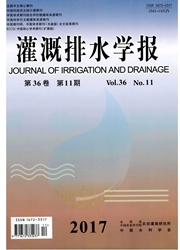

 中文摘要:
中文摘要:
为探讨不同土壤质地棉田适宜的造墒水矿化度特征值,采用坑栽土培法研究了3种土壤质地(重壤土、中壤土和砂壤土)条件下不同矿化度咸水造墒对棉花出苗率扣幼苗生长的影响。结果表明,造墒水矿化度低于2.5g/L时,处理间棉花出苗率及幼苗生长差异不明显,但随着造墒水矿化度的增加,棉花出苗率、株高、单株地上部生物量等都不同程度的受到抑制;中壤土和重壤土持水性好,比砂壤土更加适合于成水造墒播种。在重壤土和中壤土条件下,为保证相对出苗率达到75%以上,造墒水矿化度宜分别控制在6.0、6.3g/L以下。
 英文摘要:
英文摘要:
In order to study the suitable salinity of irrigation water before sowing for cotton in different soil textures, the effects of different salinity water irrigation before sowing on cotton emergence and seedling characters in different soil textures were studied through pit experiments. Results showed that mineraliza- tion of saline water below 2.5 g/L had no obvious inhibiting effect on cotton seedling growth. With the in creasing of salinity, the cotton seedling emergence rate, plant height and dry matter accumulation were re- strained in different degrees. Besides, due to higher water capacity, the heavy loam and medium loam soil were more suitable for saline water irrigation before sowing than sandy loam soil. To ensure the relative e- mergence rate was beyond 75%, the salinity of irrigation water should be below 6.0 g/L and 6.3 g/L in heavy loam and medium loam soil after 2- year continuous irrigation.
 同期刊论文项目
同期刊论文项目
 同项目期刊论文
同项目期刊论文
 期刊信息
期刊信息
